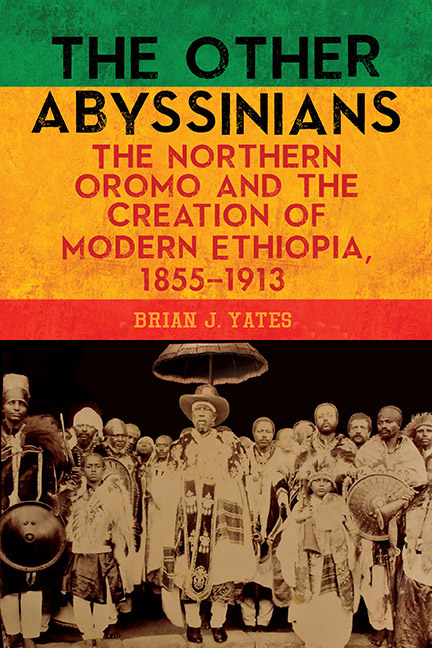Book contents
- Frontmatter
- Contents
- Preface
- Introduction: What about the Oromo Habäsha? Liberating Northern Oromo Experience from Competing Nationalisms
- 1 Cultural Backgrounds and the Habäsha State
- 2 In but not of: The (Re)Integration of the Wällo Oromo into the Habäsha Community
- 3 Menilek, Gobäna, and the Creation of Habäsha Shäwa, 1855–88
- 4 Recreating the Autonomy of Wällo: The Unions of Mikaél and Menilek
- 5 From Personal Relationships to a Centralizing State: Shäwan Ethiopia (1889–1913)
- Conclusion: The Oromo Habäsha in Modern Ethiopia
- Appendix A Guide to the Transliteration of the Ethiopic Script to the Latin Script
- Appendix B Glossary of Ethiopian Terms
- Appendix C Sample Interview Questions for Shäwa and Wällo
- Notes
- Bibliography
- Index
3 - Menilek, Gobäna, and the Creation of Habäsha Shäwa, 1855–88
Published online by Cambridge University Press: 21 March 2020
- Frontmatter
- Contents
- Preface
- Introduction: What about the Oromo Habäsha? Liberating Northern Oromo Experience from Competing Nationalisms
- 1 Cultural Backgrounds and the Habäsha State
- 2 In but not of: The (Re)Integration of the Wällo Oromo into the Habäsha Community
- 3 Menilek, Gobäna, and the Creation of Habäsha Shäwa, 1855–88
- 4 Recreating the Autonomy of Wällo: The Unions of Mikaél and Menilek
- 5 From Personal Relationships to a Centralizing State: Shäwan Ethiopia (1889–1913)
- Conclusion: The Oromo Habäsha in Modern Ethiopia
- Appendix A Guide to the Transliteration of the Ethiopic Script to the Latin Script
- Appendix B Glossary of Ethiopian Terms
- Appendix C Sample Interview Questions for Shäwa and Wällo
- Notes
- Bibliography
- Index
Summary
This chapter begins with a poem written in Amharic by an Oromo asking for help from a Mänz ruler against his enemies. This poem states, “Lend me your horse I have a journey to make to Ankober [Sahlä Sellassé's capital]/To plead for [the appointment of ] an Administrator/To protect me from my enemies.” This speaks to the extensive intertwining of the populations of Shäwa, politically, socially, and culturally. One Shäwan Oromo, Habäsha Ras Gobäna, will be highlighted as an example of both the inclusion of the Shäwan population in the Habäsha community and the specific type of Habäsha that produced modern Ethiopia. This community was marked by a syncretic culture resulting from Amhara, Oromo, Gurage, and Muslim populations. This culture also made them alien to their northern Habäsha brethren.
Gobäna Dach’é was born in Shäwa to Oromo parents, most likely of some political importance, in the early nineteenth century, and he died as one of the primary architects of Menilek's Ethiopian Empire in 1888. His life speaks to Habäsha cultural practices of inclusion, which culminated in his entrance into the Habäsha community. His grandson Wässan Säggäd, whose other grandfather was Menilek, was the chosen successor to the throne. He began in Menilek's Shäwa Ethiopia as a soldier, and as he became more successful, he became a local leader of all the Oromo south of Wällo who were a part of the Ethiopian empire. His demotion before his death marked the beginning of Menilek's shift from building alliances with local leaders to creating positions over which he had sole authority.
Shäwa, a peaceful province during the wars of the Zämänä Mäsafent, developed a political system initially drawing on Gondärine norms and was marked by centralization and widespread negotiations that eventually led to the expansion its leaders’ authority to encompass the largest empire Ethiopia has ever seen. This chapter examines key Shäwan Oromo actors who became Habäsha and the changes in Shäwan and Ethiopian political organization that led to Shäwan control over both the northern Abyssinian provinces and territories to the south, southeast, and southwest. Oromo conquests created a buffer between not only Mänz and the state centered at Gondär (or Däbrä Tabor), but also with many of the states that arose south of Shäwa.
- Type
- Chapter
- Information
- The Other AbyssiniansThe Northern Oromo and the Creation of Modern Ethiopia, 1855-1913, pp. 55 - 80Publisher: Boydell & BrewerPrint publication year: 2020



